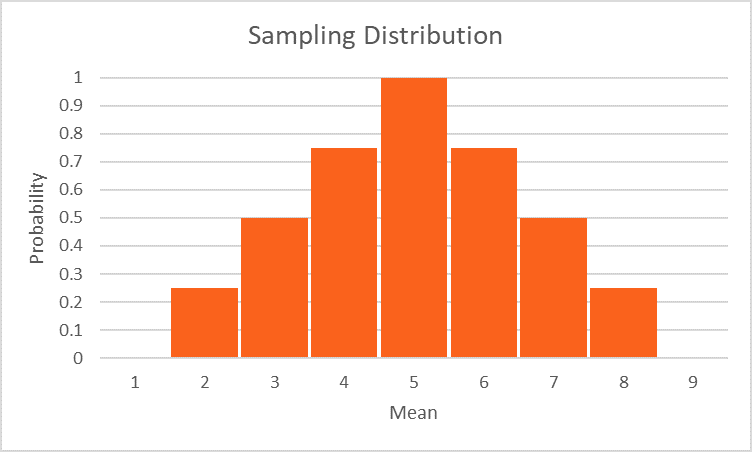What Are the Measures Used to Describe the Sample Distribution
See the equations below to calculate each of these summary statistics. The chapter closes with additional information about the normal distribution.

Sampling Distribution Overview How It Works Types
A measure of spread also called a measure of dispersion is used to describe the variability in a sample or population.
. Around 95 of values are within 2 standard deviations from the mean. It is also common to include the 5-number summary minimum value first quartile median third quartile and maximum value to describe a distribution. They are generally paired with median to describe the data.
When the mean is the most appropriate measure of center then the most appropriate measure of spread is the standard deviation. But it is also essential that we get a fair idea about how the data is distributed how scattered it is and what is the mean of the data. Paired with mean this is a good way to describe the data.
The mean of a sampling distribution equals the mean of the underlying raw score population used to create that distribution. For the continuous data test of the normality is an important step for deciding the measures of central tendency and statistical methods for data analysis. The empirical rule or the 68-95-997 rule tells you where most of your values lie in a normal distribution.
These measures refer to the dispersion of values in a distribution with relation to the mean. How To Describe The Spread Of A HistogramOne way to measure the spread also called variability or variation of the distribution is to use the approximate range covered by the data. A measure of spread sometimes also called a measure of dispersion is used to describe the variability in a sample or population.
Standard deviation is a good measure of variability for normal distributions or distributions that arent terribly skewed. Let x data value n sample size. Mean age of Australians Statistic A measure used to describe a sample distribution for example mean or standard deviation.
Measures of central tendency help you find the middle or the average of a data set. From looking at the histogram we can approximate the smallest observation min and the largest observation max. It is usually used in conjunction with a measure of central tendencies such as.
Measures of the central tendency and dispersion are used to describe the quantitative data. Variance is not used much as it is represented in squared units and is not an intuitive measure. The 3 most common measures of central tendency are the mode median and mean.
Used by marketers to describe the sample dataset in such a way as to portray the typical respondent and to reveal the general pattern of responses. Measures of spread Range Variance and Standard Deviation. Summarize and describe the extent to which scores in a distribution differ from one another b.
Collecting the data and representing it in form of tables graphs and other distributions is essential for us. Measures of variability are used to a. Measures of the Center of the Data.
Mean or standard deviation used to describe the sample distribution. The middle number in an ordered data set. The center of a data set is also a way of describing location.
The number of standard deviations that a given raw score is above or below the. Measures of Dispersion are used to estimate normal values of a dataset measures of dispersion are important for describing the spread of the data or its variation around a central value. Certain measures such as mean mode standard deviation and range.
Around 68 of values are within 1 standard deviation from the mean. In the last chapter we discussed measures of central tendency which provide three. The sum of all values divided by the total number of values.
It is usually used in conjunction with a measure of central tendency such as the mean or median to provide an overall description of a set of data. This measurement is obtained by taking the square root of the variance -- which is essentially the average squared distance between population values or sample values and the mean. A method of sampling that enables the researcher to specify for each case in the population the probability of its inclusion in the sampel.
S 2 sample variance. Measures of _____ are statistics that summarize the extent to which scores in a distribution differ from one another. Suppose that in a particular sample the mean is 7007 and the standard deviation is.
Mean is referred to as a. Which two statements describe the characteristics of probability. Measures of variability include the range the variance and the standard deviation.
Summarize and describe the extent to which scores in a distribution differ from the extreme scores c. They provide simple summaries about the sample and the measures. Around 997 of values are within 3 standard deviations from the mean.
The two most widely used measures of the center of the data are the mean average and the median. Summarize and describe measures of. Make appropriate decisions regarding graph size shape and style d.
To calculate the mean weight of 50 people add the 50 weights together and divide by 50. The most frequent value. Mean age of 500 Australians in a random sample Sample are almost never identical to the population and the real population parameter.

Level Of Significance Typical Values Are 0 01 1 Level Of Significance Typical Statistics Math Research Skills Data Science
Sampling Distribution Of The Sample Mean X Bar Biostatistics College Of Public Health And Health Professions University Of Florida

Types Of Statistics Data Science Learning Statistics Math Business Intelligence
No comments for "What Are the Measures Used to Describe the Sample Distribution"
Post a Comment